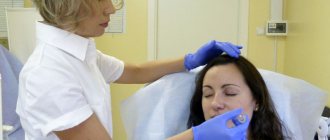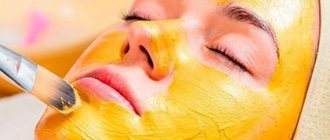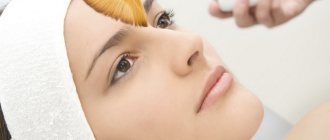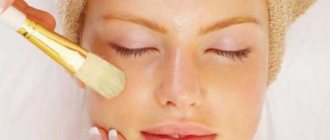Having decided to write an article on the topic “Chemical Peels,” I did not doubt for a second that I would not be doing this alone, because in practice, cosmetologists perform superficial-medium, medium and deep peels, and superficial ones are performed by cosmetology nurses. Therefore, my “right hand”, Alexandra, also took an active part in writing this article.
Everyone knows that since 2009, the profession of “cosmetologist” has officially appeared in Russia, a well-known division into “household” has taken place, and hairdressing salons, which offered “Botox injections,” have become a thing of the past. Nowadays, medical centers providing cosmetology services usually employ cosmetologists and cosmetology nurses. And this is no coincidence. The initial consultation, of course, is carried out by doctors, but then there is a “separation of powers”, all injection procedures are performed by cosmetologists, and procedures without damaging the skin are performed by cosmetology nurses. These include all types of cleansing (including ultrasonic and mechanical), massages, cosmetic treatments, eyebrow and eyelash architecture, various options for hair removal and depilation, as well as superficial chemical peels.
What is the difference: home peeling and peeling at a cosmetologist
Peels that can be used at home do not penetrate deeply into the skin and give an unnoticeable result, but they certainly help maintain an even tone and healthy skin. Chemical peels performed by estheticians have a lower pH level than at-home peels, so they can penetrate much deeper into the skin and target skin problems such as hyperpigmentation and acne. Chemical peels can cause redness of the skin; a recovery period will last for several days, during which the “old” skin will gradually peel off and renewed skin will appear.
Chemical peeling performed by cosmetologists will be much more effective for your skin than peeling at home.
Types of chemical facial peels
There are three main types, which are primarily determined by the depth of acid exposure: superficial, middle and deep.
Superficial chemical peeling
Superficial peeling is the mildest type, which is suitable for almost everyone. A special composition containing acid penetrates only into the upper layers of the epidermis; it has a gentle effect, dissolving dead skin particles without damaging or irritating the skin. The result is normalization of the sebaceous glands, narrowing of enlarged pores, drying out acne; the face gains radiance and an even tone.
Acids that are often used for superficial peeling are lactic, fruit, and less often - glycolic, carbonic.
Medium chemical peel
This is a more serious cleansing method: the acid penetrates deeper than the stratum corneum - into the middle layers of the skin located under the epidermis. The process of cell exfoliation affects not only the superficial, but also deeper layers. Medium peeling makes wrinkles, pigmentation, acne marks and scars less noticeable. The face becomes elastic, toned and fresh.
The acids most commonly used for medium peels are trichloroacetic (TCA), salicylic and retinol (vitamin A).
Deep chemical peeling
This is one of the most radical types of skin cleansing and renewal, carried out strictly in a hospital setting. Deep chemical peeling is controlled damage to the superficial and deep layers of the skin in order to exfoliate the epidermis and further intensive process of tissue regeneration (restoration). Used to eliminate scars, scars, as well as deep wrinkles and other signs of aging. The result after the procedure is completely renewed skin without signs of aging. However, do not forget that this type of peeling is nothing more than a deep chemical burn of the face; it involves a long, multi-month (up to 6 months) rehabilitation process. In modern cosmetology, deep chemical peeling is rarely used; preference is given to more gentle and safe methods.
When carrying out deep chemical peeling, compositions based on phenol (carbolic acid) are used.
Contraindications:
- The procedure is not recommended for pregnant and lactating women;
- When taking medications based on isotretinoin;
- For herpes and skin diseases;
- When taking antibiotics;
- For oncological diseases;
- For open wounds.
After a chemical peel, the skin is more sensitive to sunlight, so after the procedure it is necessary to use sunscreens and products.
Before the procedure, the cosmetologist must take into account many factors and ask all the necessary questions so that the procedure is as comfortable as possible for the client and gives the best result with the fewest possible side effects.
What problems does peeling solve?
As a rule, exfoliation is recommended for aged (after 35 years) and problem skin. The main indications for prescribing peelings include:
- dry, dull, aging skin
- long-term inflammatory skin diseases, such as acne and acne, which are characterized by the formation of pustules (pustules), comedones (blackheads) and, as a result, scars
— wrinkles (age-related, expression lines)
— premature age-related changes in the skin due to exposure to ultraviolet rays (photoaging)
– pigmentation (dark spots and freckles)
- scars, cicatrices, loss of clarity of the oval of the face
How is peeling performed and what should you pay attention to after the procedure?
Before the procedure, the skin is cleansed and “degreased”. During the procedure, you will feel warmth and burning on the treated skin surface. To reduce discomfort, you can use a fan or local anesthetic. After peeling, first of all, take care of protecting your skin from the sun, so it is not recommended to carry out the procedure at the height of summer or before leaving for warm countries.
After peeling, you will feel tightness and slight dryness of the skin. The skin may remain red for an hour after the procedure. The condition of the skin in the post-peeling period depends on the type of skin and the type of peeling performed.
It is recommended to avoid excessive physical activity and excessive sweating for several days after the procedure. Do not rub the treated skin area after peeling. Do not use retinol or AXA products for at least 10 days after peeling. Avoid visiting the sauna or bathhouse for several days.
Question to the expert
Natalya Anatolyevna, you have been a recognized expert for many years in the field of chemical peels. How has the concept of chemical peels changed recently and what place do they occupy in modern aesthetic medicine at the moment?
Peeling without destroying the basement membrane (can be of different composition - chemical, enzymatic, retinoic; can be presented in different forms - lotion, gel, cream, mask, etc.) allows you to quickly and without consequences bring the skin into a presentable appearance, very gently and safely stimulate its renewal, is a relatively inexpensive procedure of choice for the vast majority of patients and should occupy a strong position in aesthetic medicine. More traumatic types of peeling are also effective, but should be used less frequently and with more strictly verified indications. Over the past few years, I have only strengthened in this position, but the general situation demonstrates that nowadays, even during the initial visit to a cosmetologist, even patients who have no previous experience of non-traumatic care procedures are increasingly offered injection and hardware methods of influence. And patients, motivated by the media and the fear of not being like everyone else, of being irrevocably late in the fight against aging, sincerely believe in the correctness of this approach. At the same time, a paradoxical picture is often observed - many invasive expensive procedures have been performed, but the condition of the skin itself leaves much to be desired. And I just want to do a light, very superficial peel or mask and wipe the skin with lotion.
Technique
A good chemical peel for the face in a cosmetic clinic is carried out in four stages:
- Cleaning and disinfection. The skin is treated with a special milk or gel containing a weak solution of glycolic acid with surface active components. This allows you to reliably degrease the areas to be treated and eliminate contamination. The use of soap is not allowed, as this leads to severe alkalization of the skin and reduces the effectiveness of peeling.
- Application of the active agent. Using a fan brush, a cosmetologist evenly treats the skin of the face in a certain sequence: forehead, temples, chin, neck, center. The preparation for chemical peeling of the face is not applied to the moving part of the eyelids. During the procedure, the cosmetologist constantly monitors the patient’s condition and maintains precise timing. A slight burning sensation is considered normal, but should not become unbearable. After diffuse erythema appears on the skin, proceed to the next stage of the procedure.
- Neutralization of acid. Deactivation of the peeling agent is carried out using a special neutralizer. It completely stops the drug from working. Residues of the base substance and neutralizer should be washed off with cool water. Chemical glycolic facial peeling does not require the use of deactivators. The product is removed from the skin surface by simple washing.
- Post-peeling care. After deactivating the acid, the cosmetologist treats the patient’s face with a special post-peeling cream. This is necessary, since during the procedure the epidermis is severely dehydrated and needs to compensate for fluid loss.
In the future, it is necessary to use sunscreens, moisturizers, and wash your face twice a day with a warm chamomile decoction without detergents. If your skin feels dry and tight, it is recommended to spray your face with a thermal spray. After medium chemical peels of the face, crusts form on the face and crack. It is forbidden to tear them down by force. Hydrocortisone ointment is applied to the damaged areas. Peeling and separation of crusts stops by 5–7 days after the procedure.
Peeling results
Facial skin peeling allows you to achieve the following positive changes:
- the color and texture of the skin becomes smoother;
- fine wrinkles disappear;
- deep wrinkles become less noticeable;
- a prolonged effect of skin moisturizing is achieved;
- the tone of the outer integument of the body increases;
- zones of hyperpigmentation are eliminated or become almost invisible;
- local immune reactions are enhanced.
Consequences if the procedure is carried out incorrectly
These changes are achieved after complete restoration of the skin. Until this point, a person may experience certain negative consequences, which soon go away on their own. These include:
- For superficial peeling – persistent erythema, dyschromia, infection, contact and allergic dermatitis. Similar reactions are accompanied by chemical glycolic facial peeling.
- For medium peeling – the appearance of a peeling crust and burn exudate.
- For deep chemical peeling of the face – the appearance of erythema, pastiness, local inflammatory reaction, swelling.
It must be remembered that all of these conditions fall into the category of expected and completely controllable. They do not pose a threat to life, health or appearance, and if all recommended recovery measures are followed, they pass without delayed consequences.
Composition selection
You can prepare a homemade peeling product yourself from natural products or buy a ready-made composition.
Let's look at what components will help cleanse the skin for different skin types:
- Dry. Low-abrasive components (flour, coffee grounds, pine nuts, crushed wheat flakes) are suitable for mechanical exfoliation of keratinized particles. The most suitable compositions for the chemical procedure are fruit pulp or juice, fermented milk products, honey, and herbal decoctions that are applied to the face.
- Fat. More aggressive agents are used (salt, soda, ammonia, boric acid, cane sugar).
- Normal. Peeling for this type of epidermis is preventive in nature. Vegetable pulp, coffee grounds, crushed tea leaves, ground oatmeal and nuts are suitable for the procedures. In order not to provoke thinning of the skin of the face, you should not get carried away with abrasive components.
- Fading. Aging dermis should not be subjected to aggressive cleansing methods. Good results are achieved by gentle peelings with fermented milk products (kefir, yogurt, sour cream), with oatmeal and milk, poppy seeds and sea salt with the addition of softening ingredients (vegetable oil, egg yolk, cream or honey).
When choosing a peeling composition, you need to take into account your skin type, age, the possibility of a recovery period, as well as the expected result. Better results can be achieved by using additional accessories (glove, brush or washcloth) during the procedure.
Who is the procedure not recommended for?
Contraindications to exfoliation are:
- herpes infection and other infectious diseases in the active stage
- diseases of the kidneys, liver, cardiovascular system, cancer and other severe somatic diseases
- diabetes
– pregnancy and breastfeeding period
- minor age (under 18 years old)
- individual intolerance and allergic reaction to the ingredients of the composition
- damage to the skin, inflammation of the skin
Before the exfoliation procedure, consultation with a specialist is necessary in any case, because In addition to absolute contraindications, there are other reasons that may justify postponing the procedure for some time. Thus, peeling is not recommended while taking a number of medications (immunosuppressants, retinoids, etc.) or in the case of recently performed traumatic cosmetic procedures (deep cleaning, mesotherapy, etc.). In addition, contraindications also include the presence of a tan and menstruation period.










